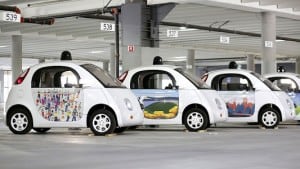 Yesterday, a Google self-driving vehicle was pulled over by the Mountain View Police for driving too slow. Google is trying to turn the episode into a cute dispute to show how safe their vehicles are. The little marshmallow self-driving Google cars are not capped at 25 mph for safety as stated by the Google Self-driving car Google+ page. They are capped at 25 mph because the are classified as a low-speed vehicle (LSV) neighborhood vehicle. The little bug-eye kiosks with murals from artists are not safe at speeds above 25 mph.
Yesterday, a Google self-driving vehicle was pulled over by the Mountain View Police for driving too slow. Google is trying to turn the episode into a cute dispute to show how safe their vehicles are. The little marshmallow self-driving Google cars are not capped at 25 mph for safety as stated by the Google Self-driving car Google+ page. They are capped at 25 mph because the are classified as a low-speed vehicle (LSV) neighborhood vehicle. The little bug-eye kiosks with murals from artists are not safe at speeds above 25 mph.
“The Google vehicles are capped it at 25 mph because it’s the law. LSV’s tend to be very slow and annoying and they are really not much more than golf carts. They don’t have air bags or safety features necessary for regular cars,” confirmed John J. Simpson, Consumer Watchdog’s Privacy Project director.
The Google car was going 24 mph in a 35 mph zone, according to the Mountain View Police Department with cars stacking up behind it.
The officer informed the human driver of impeding traffic per 22400(a) of the California Vehicle Code. Since the car is a LSV, it falls under Neighborhood Electric Vehicle Definition per 385.5 of the California Vehicle Code and can only be operated on roadways with speed limits at or under 35 mph. In this case, it was lawful for the car to be traveling on the street as El Camino Real is rated at 35 mph, however it can’t go on roads at 40 mph limits. The Google car could have been cited for impeding traffic but received a warning from the police officer.
Self-driving cars driving at slow speeds can prompt other vehicles to take necessary risks to go around them or rear-end the vehicle. This is always a problem that these cars can cause accidents says Consumer Watchdog’s Simpson who believes that all information about self-driving car collisions should be shared with the public and even other self-driving technology companies to learn from the mistakes and prevent future accidents.
“It is self-evident that if something goes wrong with a crash all the data and video should be made public. People working on self-driving technology can correct their technology and the problem, also,” added Simpson whose organization is advocating for video and data of self-driving car accidents to made public as part of the law with the California Department of Motor Vehicles. Due the group’s efforts, the California Department of Motor Vehicles posts all autonomous vehicle accident reports on its website.
 Cars that drive slower than the rest of traffic speed on the road can be dangerous and cause accidents. So far, Google in self-reporting rear-ended collisions blames it on the people driving behind the car. Since the company that owns the cars, makes the accident report in California, it’s like Volkswagen reporting its own diesel emissions, some argue.
Cars that drive slower than the rest of traffic speed on the road can be dangerous and cause accidents. So far, Google in self-reporting rear-ended collisions blames it on the people driving behind the car. Since the company that owns the cars, makes the accident report in California, it’s like Volkswagen reporting its own diesel emissions, some argue.
We noted previously that the video of the self-driving car accidents should be posted for all the share for everyone’s safety and knowledge.
Consumer Watchdog expects to receive a ruling from the California Department of Motor Vehicles on its request for the data and video to be shared from self-driving cars when involved in accidents, says Simpson.
We support Consumer Watchdog for following up on our question we asked when the first accidents occurred, “They have cameras on the cars, why don’t they have to show video footage of what happened?”
Researchers suggest that self-driving cars should be tested and get learners’ permits and drivers’ licenses.
It would seem to me that if the law says vehicles capped at 25 mph can legally operate on roads with 35 mph limits it’s not possible to be cited for driving too slow at 25 mph in a low-speed vehicle. It was a bogus traffic stop.
It is the behavior of the DRIVERS of the vehicles behind that is dangerous!
This excellent post fills in the legal gaps for us international readers – perhaps Google should consider using Smart cars instead – they are only a little bit bigger, but will be fully equipped for regular speeds on both city & open roads.
Or is there something else that Google is not telling us about the safety of autonomous driving?
Google does not tell the world how it changes it search engines. Google spends millions of dollars lobbying Congress. People in the car industry know that LSV are not safe. I drove behind an LSV on a local town, it was way below the speed of what other people were driving. Cars stacked up behind it. The Grandpa marshmallows cause the traffic around it to go crazy!